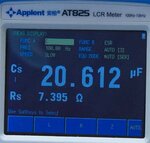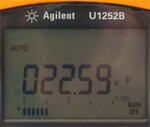Veketti
Full Member level 3
Dear All,
I just bought my first LCR meter Applent AT825 and faced issue when testing it. I measured capacitance of 22 uf Panasonic NHG series aluminium electrolytic capacitor with this meter and same thing with Agilent U1252B multimeter. Well Applent is 4 wire meter and dedicated measure this but Agilent tells it has error max. 1%. Look at the differences, I don't understand why is there so big differences:


Applent is measuring with 100Hz but I don't find from Agilent manual what frequency it is using. It only says display update rate 4 times/sec so is it 4Hz? Which one is showing the right thing, please could someone explain?
btw. there was test report included with the Applent telling there is only 0.0016uF error on 10uF range.
Thank you in advance. Your help is greatly appreciated.
I just bought my first LCR meter Applent AT825 and faced issue when testing it. I measured capacitance of 22 uf Panasonic NHG series aluminium electrolytic capacitor with this meter and same thing with Agilent U1252B multimeter. Well Applent is 4 wire meter and dedicated measure this but Agilent tells it has error max. 1%. Look at the differences, I don't understand why is there so big differences:


Applent is measuring with 100Hz but I don't find from Agilent manual what frequency it is using. It only says display update rate 4 times/sec so is it 4Hz? Which one is showing the right thing, please could someone explain?
btw. there was test report included with the Applent telling there is only 0.0016uF error on 10uF range.
Thank you in advance. Your help is greatly appreciated.